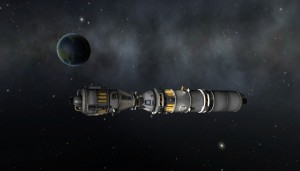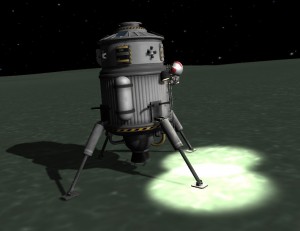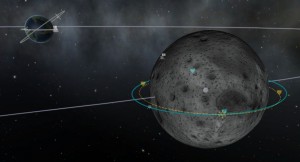You’re going to space today
During my ongoing literature review I often discover interesting facts about things I’ve never thought about. Sometimes I can connect these facts with my own observations: The result is mostly a completely new idea why things are as they are. Maybe these ideas are new to you, too. Therefore I’ll share my new science based knowledge with you!
This week: This time, I’ll present the space travel simulation game „Kerbal Space Program“. The game is combining gamefulness with real world science and is thus increasing the interest in real world science.
Kerbal Space Program[1] (KSP) allows the player to create own space crafts and fly them afterwards through space. During gameplay players can manage their own space program, build orbital stations, land on other planets or moons and explore the vastness of space. At a first glance, this might sound quite trival, but after a short time of playing the game, it becomes clear that the game is more complex than it sounds.
KSP is based on real physics and thus creates a realistic simulation of space travel. After assembling the first space craft, the player can launch it from the space port and – hopefully – reach a stable orbit. However this isn’t easy to new players who possible do not much about space travel[2]. Just flying straight up (and not falling apart due to an constructional fault) won’t put the craft into orbit: it’ll only reach a maximum height and afterwards descend back to Kerbin (that’s the „Earth“ of the game). If the craft reaches a stable orbit around Kerbin, the gamer can start practicing basic orbital maneuvers: changing the inclination or increasing/decreasing the apoapsis/periapsis.
Finally the user has learnt the basics of controlling a space craft. But what about making a rendezvous with another craft? What about docking? Fortunately there’re many tutorials [3] how to perform a certain task. The next step could be the landing on an other celestial body–in most cases it’s on one of the two moons of Kerbin. In order to land on a moon, the space craft needs to reach it. Naturally this requires even more knowledge about space travel.
Players who do have a deep knowledge about space travel can actually calculate their maneuvers. The whole game is based on math and physics[4]. Formulars of rocket science can be applied to calculate the delta-v of the assembled space craft[5].
The game does not give a clear goal. The latest version of it is a sandbox game allowing the players to set their own goals while exploring the solar system. However to successfully reach the own goals, the game is requiring a lot of knowledge about space travel. During my own gameplay I’ve learnt a lot about space flights and orbital maneuvers.
The game follows the concept of two previously presented games[5] by setting the game in a scientific context and creating a realistic environment. Just by playing this game, gamers learn a lot about space travel and if they’re interested in doing things efficiently, they’ll start to look up calculations and procedures used in real world space travel.
In conclusion KSP is a great game that can also be categorized as edutainment software. Exploring space is a very interesting topic and has a lot of potential to connect gamefulness with real world science. In the end, this might lead to an increased overall interest in space travel and other sciences connected with it.


